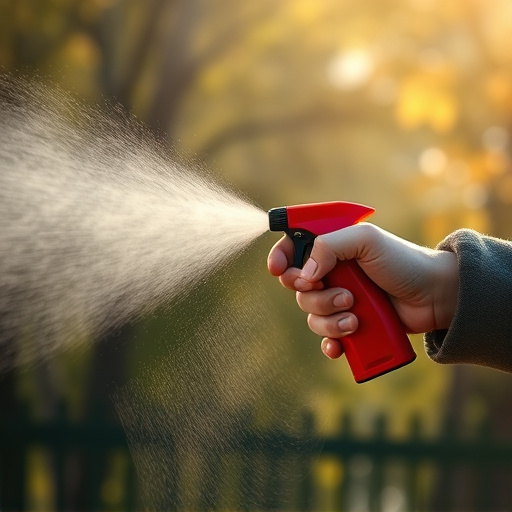The strongest legal pepper spray concentration (2%+ oleoresin capsicum, OC) is a vital tool for law enforcement in crowd control and riot management, offering rapid de-escalation and safety during demonstrations and civil unrest. Global regulations vary, with concentrations between 2% to 5% commonly used, while higher potency options up to 10%+ are available for maximum effectiveness. Balancing potency and safety is crucial, requiring adherence to legal guidelines and reputable brands with clear labeling.
In the realm of law enforcement, riot control is a complex challenge. Understanding and managing large-scale public gatherings require effective tools. One such tool, pepper spray, has been a subject of intense debate due to its controversial nature. This article delves into the world of riot control, focusing on the pivotal role of inflammatory sprays. We explore the legalities surrounding these products, specifically examining the strongest legal pepper spray concentrations permitted for use by authorities.
- Understanding Riot Control and its Challenges
- The Role of Pepper Spray in Law Enforcement
- Deciphering Legalities: Highest Concentration Allowed
- Exploring the Strongest Legal Pepper Spray Options Available
Understanding Riot Control and its Challenges
Riot control is a complex challenge faced by law enforcement agencies worldwide, often requiring specialized equipment and tactics to manage large-scale public disorder. In such volatile situations, the primary goal is to de-escalate tensions and restore order while ensuring the safety of both officers and civilians. One of the most commonly used tools in riot control is pepper spray, a non-lethal agent designed to temporarily incapacitate individuals and disperse crowds.
The effectiveness of pepper spray relies heavily on its concentration, with the strongest legal pepper spray concentration offering superior performance. This high-concentration formula can quickly disable rioters, providing critical time for authorities to gain control. In the face of growing crowd aggression and the potential for violent clashes, law enforcement agencies are increasingly turning to advanced pepper spray technologies, prioritizing the highest strength levels to meet the demands of modern riot control operations.
The Role of Pepper Spray in Law Enforcement
Pepper spray, also known as oleoresin capsicum (OC) spray, has become an indispensable tool in law enforcement’s arsenal for crowd control and riot management. Its primary role is to temporarily disable or deter aggressive individuals, providing officers with crucial time to de-escalate tense situations and restore order. The effectiveness of pepper spray lies in its ability to cause a burning sensation, pain, and temporary blindness, making it a powerful non-lethal option for dealing with resistant suspects.
When it comes to law enforcement applications, the strongest legal pepper spray concentration is often sought after for its rapid impact and reliability. High-strength sprays, typically containing OC at concentrations of 2% or more, offer a swift response, ensuring officers can control chaotic scenarios quickly. This specialized equipment plays a vital role in maintaining public safety, especially during demonstrations, civil unrest, or high-risk arrests, where de-escalation tactics are essential.
Deciphering Legalities: Highest Concentration Allowed
In the realm of riot control, understanding the legalities surrounding inflammatory spray is paramount. The strongest legal pepper spray concentration varies across jurisdictions, with each country and region setting its own guidelines based on public safety considerations. Law enforcement agencies must adhere to these regulations to ensure their tactics are both effective and within legal limits.
When discussing the strongest legal pepper spray concentration, it’s essential to focus on active ingredients like capsaicin or oleoresin capsicum (OC). These substances are known for their irritant properties, causing temporary blindness, difficulty breathing, and intense pain. However, regulatory bodies set maximum permitted levels to prevent excessive harm to civilians. Staying informed about these legal parameters is crucial for both authorities employing such tactics and individuals concerned about public safety in high-conflict areas.
Exploring the Strongest Legal Pepper Spray Options Available
When it comes to choosing the strongest legal pepper spray for riot control, understanding the concentration is key. The active ingredient in pepper spray is capsaicin, and its potency is measured in percent or parts per million (ppm). For law enforcement and security purposes, pepper sprays with concentrations ranging from 2% to 5% are commonly used, as they provide a powerful yet controlled effect. However, for those seeking the absolute strongest legal option, concentrations of 10% and above are available.
These higher concentrations offer enhanced effectiveness in crowd control scenarios, ensuring swift and effective dispersal. Yet, it’s essential to note that strength should not compromise safety. All pepper sprays, regardless of concentration, must adhere to legal guidelines and standards to ensure they are safe for both users and bystanders. Always opt for reputable brands that provide clear labeling and information on their products’ active ingredients and safety measures.
In conclusion, while pepper spray plays a significant role in riot control, navigating its legalities and understanding the strongest legal pepper spray concentration are crucial. As discussed, the optimal concentration varies by region, but globally, the most effective options lie within the 1.5% to 2% capsaicin range. Law enforcement agencies must strike a balance between crowd control and safety, ensuring that their chosen inflammatory spray adheres to legal limits while remaining potent enough to effectively manage disturbances.
